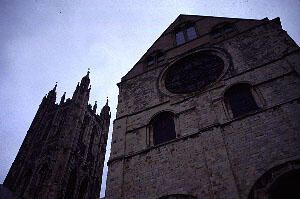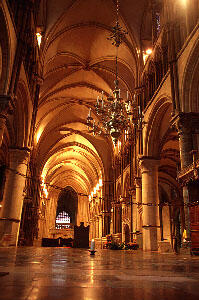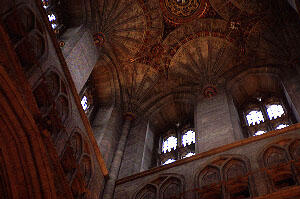Introduction
With major expansion and construction works, medieval England was an important time in architectural and art history. This paper traces the importance of the architecture of medieval cathedrals in the context of functionality. This will be done in the context of the Canterbury Cathedral. To begin with, a cathedral may be described as a church that holds the seat of the bishop. It is generally Roman Catholic in nature. (Gimpel, 1983. pp. 65 to 77). Since time immemorial, a cathedral has been seen as an important place of reverence and worship. It is a place where important occasions and rituals take place in accordance with the norms of religion (Gimpel, 1983). These events generally happen under the supervision or watchful eye of the bishop, thereby making the details even more auspicious. In medieval times, the cathedrals were places where important meetings and developments regarding society and rituals would take place. (Coldstream, 2002; pp. 55 to 83)
Main body
The Canterbury Cathedral saw its first archbishop in the form of St. Augustine in the year 597 AD. During this period, cathedrals were built from the taxes collected from poor peasants. This was symbolic of the reverence and fear attached to the actual perception of a cathedral (Webb, 2007; pp. 26 to 39) As the oldest and one of the most important features of Christianity and medieval England, the Canterbury Cathedral has stood the test of time to emerge as a structure that evokes respect and the silent murmurings of history through its walls and pillars. (Cliffton et al, 1989) Dedicated to St. Saviour, this cathedral was the first Saxon cathedral that followed the Roman road of laying foundations (Coldstream, 2002; pp. 175 to 200).
Architectural Features
One of the most important aspects of any cathedral, and the Canterbury Cathedral, in particular, are its pillars and central dome. The Canterbury Cathedral follows the Perpendicular Gothic style of architecture (Cliffton et al, 1989). This can be seen in the picture below:

This picture shows the steep towers and grey exterior that is typical of that period of England’s architectural history. The placement of the round skylight and the two windows underneath it gives the structure an almost palpable and tangible character. Further, the unbroken pillars and lines virtually pull the structure together and give it greater length as well as stature (Cliffton et al, 1989). This has only contributed to the awe-inspiring nature of the structure. This feature of neat and uninterrupted lines can be seen throughout the interior of the cathedral as well. This also helps gives the inside of the cathedral a well-lit look. In addition, there is an air of peace and serenity that plays down the Gothic element in the architecture of the structure. Instead, by playing up the lines, there is an affinity towards embracing the teachings of the religion and connect with the power that transcends from an upward force (Webb, 2007; pp. 26 to 39). The uninterrupted lines that are characteristic of a perpendicular style of architecture can be seen in the picture below.

In addition to these features, the central tower that was added to the structure in 1490 helped the structure gather momentum in terms of its length and flow (Webb, 2007; pp. 26 to 39). This is depicted in the picture below. This picture shows how the intricacy of the central tower contributes to the starkness of the rest of the structure.

Key Functionality: Methodological Context
The Canterbury Cathedral employed symbolic architecture as one of its major features. One of the most important functions of the Cathedral remains in its position as one of the most powerful seats of the archbishop in the Middle Ages. This fact was further fuelled by the various developments that took place within the cathedral and its direct jurisdiction. Having begun during the reign of William the Conqueror, the Cathedral is a hangover from the influences from Normandy and French Gothic styles. This was due to the fact that the Normans used the semi-skilled Saxons for the purpose of cutting stones and laying floors (Webb, 2007; pp. 26 to 39).
The Canterbury Cathedral has gone through periods of vaulted structures and hollow pillars as well as those of the expansion of the Nave floor and foundations of other structures along the same axes, during the time of Archbishop Cuthbert (740 – 758) and Oda (941 – 958). This was followed closely by the rendering of more modern lines by the Norman archbishop Lanfranc. From here, it went on to embrace the perpendicular lines in the Gothic context under the archbishop Thomas Chillenden (1390 – 1410). (Cliffton et al, 1989) This cathedral embraced symbolic architecture which was a characteristic of the perpendicular gothic style. In the case of this cathedral, it may be seen that the symbolism in the structure came from the varied influences of the combination of Gothic and Saxon as well as Norman styles. This in itself lent a methodological approach to the architecture and future additions to the structure (Coldstream, 2002; pp. 149 to 175).
In lieu of all of these developments, it may be noticed that politics and social life revolved around subtle architectural changes. The 1170 murder of Thomas Becket in the older Norman cathedral, held the people in a grip of fear regarding the traditions that had earlier bound them. Further, the affinity of the Cathedral to William the Conqueror following the accession of Lanfranc was a matter of concern for the people who went to the cathedral. The positive aspect was that there was strength in this methodological approach was that the rulings that came from within the cathedral bound the people together, while the drawback was the fear that it invoked. The architecture that followed was a matter of great innovation with the French influences. The complete removal of Norman’s influence was seen as a welcome change. It may, however, be noted that the only remaining Norman feature in the cathedral includes the crypt (Gimpel, 1983).
Conclusion
The cathedrals in medieval times were important places due to the fact that they held important figures and saints in their crypts and history. Further, any upheaval or change in the ruling force in the land was first seen in changes that were embedded into the religious structures. The strength of such a methodological approach lies in the fact that the information regarding the new rules as well as norms and rituals were passed along through the force and power that was a part of the cathedral’s image. The weakness of such an approach lay in the fact that the poor peasants were the worst sufferers as they had to pay higher taxes to support constant renovations. The image of the cathedral was an all-important factor in the lives of people who lives around it and in tandem with its norms and rituals. This was one of the key functional areas in which the cathedrals of medieval times operated. The cathedrals were viewed as the playgrounds of the political powers that went by the titles of archbishops. They were used to monitor the cultural developments as well as the societal norms within which people conducted themselves. This is a case of symbolic architecture. It may be seen that the basic functionality of the Cathedrals also worked towards the fact that they gave importance to the people who were involved in building or restoring them. This may also be found true of religious works of art. These works, therefore, created the scope for artisans and architects to be known in their areas and beyond. The cathedrals, with their awe-inspiring structures in terms of pillars and columns, became synonymous with power and respect. It was a known fact that such features could not be replicated in the residences of humble people and this served as one of the key functions that set the cathedral apart from any other structure. The payment of taxes and other activities revolved around the needs of the cathedrals. This drew in importance as well as reverence. The motions and movements that took place within the society often came from the rulings that emanated from within the cathedral. Even the rulers of the time affiliated themselves with the cathedral and its powers.
References
Coldstream, Nicola (2002). Medieval Architecture. Oxford University Press.
Williams Edu.
Gimpel, Jean (1983). The Cathedral Builders. Grove Press.
Webb, Diana (2007). Pilgrimage in Medieval England. Hambeldon and London.
Cliffton, A C; Hurlimann, M (1989). The Cathedrals of England. Thames and Hudson.